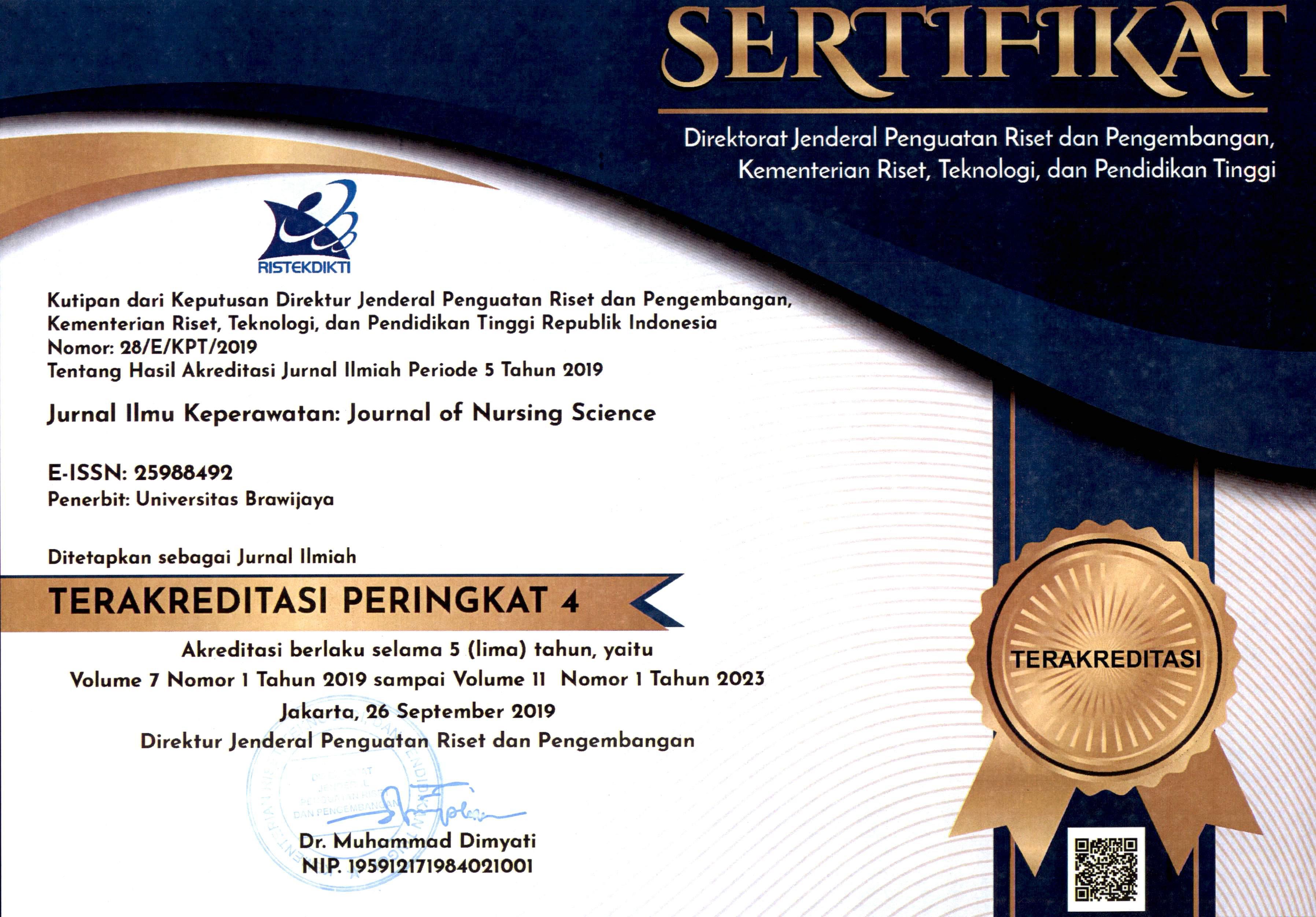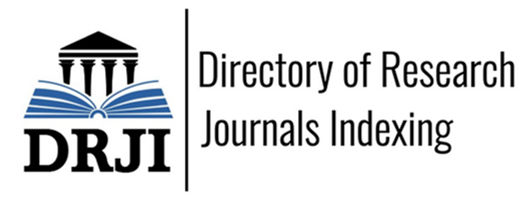THE EXPERIENCE OF TEMS NURSES IN HANDLING TRAFFIC ACCIDENT VICTIMS IN RSUD DR. ISKAK TULUNGAGUNG
DOI:
https://doi.org/10.21776/ub.jik.2018.006.01.7Keywords:
TEMS Nurse, Handling of Traffic Accident VictimsAbstract
References
- Al-Shaqsi, S. (2010). Models of International Emergency Medical Service (EMS) Systems, Oman Medical Journal. 25 (4): 320-323.
- Aminizadeh, M., et al. (2014). Experiences ofemergency medical service personnel: (A qualitative study), J Nov. Appl Sci. 3 (9): 967-970.
- Berben, S.A.A., et al. (2012). Facilitators and barriers in pain management for trauma patients in the chain of emergency care, Injury, Int. J. Care Injured. 43: 1397-1402.
- Bigham, B.L., et al. (2010). Knowledgetranslation in emergency medical
- services: A qualitative survey of barriers to guideline implementation, J.
- Resuscitation. 81: 836-840.
- Bigham, B.L., et al. (2014). Paramedic Self-reported Exposure to Violence in the Emergency Medical Services (EMS) Workplace: A Mixed-methods Crosssectional Survey, Journal Prehospital Emergency Care. 18 (4) : 489-494.
- Boyle, M., Wallis, J., & Suryanto. (2016). Pre-hospital care in developing countries,Australasian Journal of Paramedicine. 13
- (3) : 1-2.
- Djaja, S., et al. (2016). Gambaran Kecelakaan Lalu Lintas Di Indonesia Tahun 2010- 2014, Jurnal Ekologi Kesehatan. 15 (1):
- – 42.
- Gondocs, Z., et al. (2010). PrehospitalEmergency Care in Hungary: What can we learn from the past?,The Journal of Emergency Medicine. 39 (4): 512-518.
- Gonzalez, R.P., et al. (2009). Does increased emergency medical services prehospital time affect patient mortality in rural motor vehicle crashes? A statewide analysis, The American journal of
- surgery. 197 (1): 30-34.
- Holmberg, M., & Fagerberg, I. (2010). The encounter with the unknown: Nurses lived experiences of their responsibility for the care of the patient in the Swedish ambulance service, Int J Qual Stud Health Well-being. 5 (2) : 1-9.
- Maragh-Bass, A.C., Fields, J.C., McWilliams, J., dan Knowlton, A.R. (2017). Challengesand Opportunities to Engaging Emergency Medical Service Providers in Substance Use Research: A Qualitative Study, Prehosp Disaster Med. 26:1-8.
- Newgard, C. D., et al. (2010). Emergency medical services intervals and survival in trauma: assessment of the “Golden Hour†in a North American Prospective Cohort, Annals of Emergency Medicine. 55 (3): 235-240.
- Nielsen, K., et al. (2012). Assessment of the Status of Prehospital Care in 13 Low and Middle-Income Countries, Journal Prehospital Emergency Care. 16 (3):
- Romanzini, E. M., & Bock, L. F. (2010). Conceptions and feelings of nurses working in emergency medical services about their professional practice and training, Rev Lat Am Enfermagem. 18 (2) : 240-246.
- Sánchez-Mangas, R., et al. (2010). The probability of death in road traffic
- accidents. How important is a quick medical response?,Accident Analysis and Prevention. 42 (2010): 1048-1056.
- WHO. (2015). Global status report on road safety 2015. WHO: Switzerland
Published
How to Cite
License
Authors published in this journal agree to the following terms:
1. The copyright of the received article shall be assigned to the journal as the publisher of the journal. The intended copyright includes the right to publish the article in various forms (including reprints). The journal maintains the publishing rights to the published articles.
2. Authors may enter into separate additional contractual agreements for the non-exclusive distribution of the published journal version of the work (for example, posting it to an institutional repository or publishing it in a book), with acknowledgment of their initial publication in this journal.
3. Authors are permitted and encouraged to post their work online (e.g. in an Institutional Repository or on their website) before and during the submission process, as this can result in a productive exchange, as well as earlier and larger citations of the published work.
4. Articles and all related material published are distributed under Creative Commons Attribution-NonCommercial 4.0 International License or CC BY-NC 4.0 license.
JNSU is licensed under a Creative Commons Attribution-NonCommercial 4.0 International License or CC BY-NC 4.0 license.
Most read articles by the same author(s)
- Bintari Ratih Kusumaningrum, Indah Winarni, Setyoadi Setyoadi, Kumboyono Kumboyono, Retty Ratnawati, PENGALAMAN PERAWAT UNIT GAWAT DARURAT (UGD) PUSKESMAS DALAM MERAWAT KORBAN KECELAKAAN LALU LINTAS , Journal of Nursing Science Update (JNSU): Vol. 1 No. 2 (2013)
- Retno Lestari, Titin Andri Wihastuti, Berty Febrianti Rahayu, HUBUNGAN TINGKAT KECEMASAN DENGAN TINGKAT KEMANDIRIAN ACTIVITIES OF DAILY LIVING (ADL) PADA LANJUT USIA DI PANTI WERDHA , Journal of Nursing Science Update (JNSU): Vol. 1 No. 2 (2013)
- Athi' Linda Yani, Indah Winarni, Retno Lestari, EKSPLORASI FENOMENA KORBAN BULLYING PADA KESEHATAN JIWA REMAJA DI PESANTREN , Journal of Nursing Science Update (JNSU): Vol. 4 No. 2 (2016)
- Maria Imaculata Ose, Retty Ratnawati, Retno Lestari, STUDI FENOMENOLOGI PENGALAMAN PERAWAT INSTALASI GAWAT DARURAT (IGD) DALAM MERAWAT PASIEN TERLANTAR PADA FASE END OF LIFE DI RSUD Dr. SAIFUL ANWAR MALANG , Journal of Nursing Science Update (JNSU): Vol. 4 No. 2 (2016)
- Ika Setyo Rini, Dini Widya Ayuningtyas, Retty Ratnawati, FAKTOR-FAKTOR YANG BERHUBUNGAN DENGAN PERSEPSI GEJALA NYERI DADA KARDIAKISKEMIK PADA PASIEN INFARK MIOKARD AKUT DI RSUD dr. SAIFUL ANWAR MALANG , Journal of Nursing Science Update (JNSU): Vol. 5 No. 1 (2017)
- Iva Milia Hani Rahmawati, Retty Ratnawati, Septi Dewi Rachmawati, PENGALAMAN PERAWAT DALAM MEMBERIKAN LAYANAN KEPERAWATAN JIWA PADA PECANDU NAPZA DI PUSAT REHABILITASI BADAN NARKOTIKA NASIONAL KARESIDENAN KEDIRI , Journal of Nursing Science Update (JNSU): Vol. 4 No. 2 (2016)
- Yati Nur Azizah, Retty Ratnawati, Setyoadi Setyoadi, PENGALAMAN PERAWAT DALAM MELAKUKAN PENILAIAN CEPAT KESEHATAN KEJADIAN BENCANA PADA TANGGAP DARURAT BENCANA ERUPSI GUNUNG KELUD TAHUN 2014 DI KABUPATEN MALANG (STUDI FENOMENOLOGI) , Journal of Nursing Science Update (JNSU): Vol. 3 No. 2 (2015)
- Fransiska Erna Damayanti, Retty Ratnawati, Fransiska Imavike Fevriasanty, PENGALAMAN ISTRI TENTARA (TNI-AD) YANG TINGGAL DI BATALYON SAAT SUAMI BERTUGAS DI DAERAH RAWAN KONFLIK , Journal of Nursing Science Update (JNSU): Vol. 4 No. 2 (2016)
- Sutono Sutono, Retty Ratnawati, Tony Suharsono, PERBEDAAN NILAI KOMPRESI DADA DAN VENTILASI PADA PELATIHAN RESUSITASI JANTUNG PARU MAHASISWA S1 KEPERAWATAN DENGAN UMPAN BALIK INSTRUKTUR, AUDIOVISUAL DAN KOMBINASI DI YOGYAKARTA , Journal of Nursing Science Update (JNSU): Vol. 3 No. 2 (2015)
- Merry Januar Firstiana, Retty Ratnawati, Retno Lestari, FENOMENOLOGI : PENGALAMAN CARING PERAWAT PADA PASIEN TRAUMA DENGAN KONDISI KRITIS (P1) DI IGD RSUD TARAKAN-KALIMANTAN UTARA , Journal of Nursing Science Update (JNSU): Vol. 5 No. 1 (2017)






























